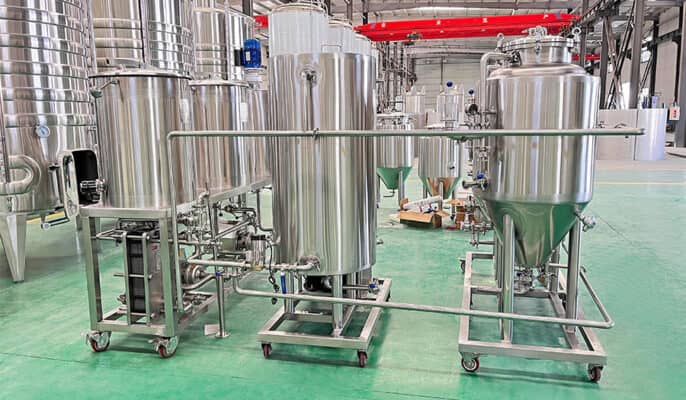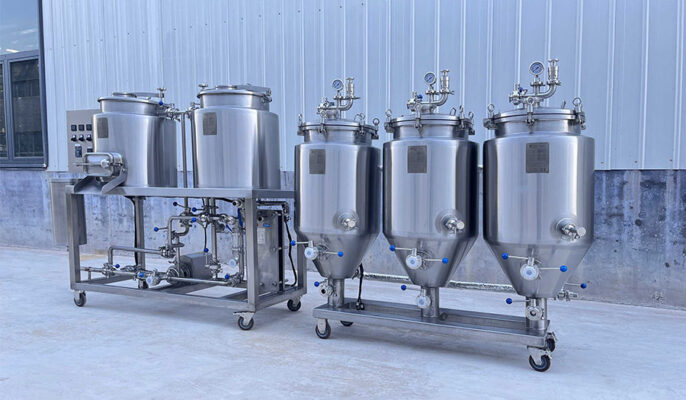A brew kettle is one of the basic and important tools in the beer-making process. Whether you are a beer brewing enthusiast or a professional brewer, understanding the basics of how to choose a brew kettle is essential to producing high-quality beer. Stainless steel brewing kettles not only affect the consistency and flavor of your beer but also have a direct impact on the efficiency and ease of operation. In this guide, Micet Group will walk you through the process of choosing the ideal beer brewing pot for your needs. From the different types and materials available to the various features and sizes to consider, we will provide you with all the information you need to make an informed decision.
What is a stainless steel brew kettle?
Brew kettles are large vessels used to boil ingredients and extract flavors during the brewing process. They play a vital role in achieving the desired flavor, aroma, and color of the beer. Precision and attention to detail are key when brewing beer. Brew kettles provide brewers with the control needed to make the perfect beer. From sanitizing to hop utilization, these pots are essential at every step of the brewing process. Stainless steel brew kettles are ideal for brewing beer because they are durable, corrosion-resistant, less reactive, and easy to clean and sanitize. It is also a relatively low-cost option compared to other materials such as copper or aluminum, especially considering the cost over its entire lifespan.

Selection of material for brewing kettle
There are many brewing kettles available in the market and when choosing a brewing kettle, it is important to be clear about its material, function, etc.
Aluminum Brewing Kettles
Aluminum is another common material used to make brewing kettles. It has its advantages such as light weight and better heat conductivity than stainless steel. It is also cheaper. However, it also has disadvantages. For example, the color of aluminum kettles can fade or discolor. It reacts poorly with certain chemicals and can damage the pot. In fact, in some cases, aluminum can be shed into the brew and mixed with the product.
To prevent this, you can boil some water in your kettle before using it. This will release the aluminum oxide and protect the metal from oxygen. This is a good thing because oxygen is very unreactive with aluminum. This process also helps prevent aluminum from leaching out of the wort.
Hervidor de cerveza de acero inoxidable
The brewing process requires high heat and pressure. Stainless steel is an excellent choice because it can withstand frequent heating and high-temperature ranges without warping or corroding as long as proper care and maintenance guidelines are followed. Stainless steel has much better corrosion resistance compared to regular steel, iron, or aluminum. Stainless steel does not react with acids or produce or alter flavors in any way, so it can be used safely batch after batch without affecting consistency or compromising the final product.
The passivation layer on the surface of stainless steel is smooth enough to make sanitizing with chemicals or steam very simple. This saves time and money while ensuring proper sanitation practices are maintained throughout all stages of production in the brewery.
Copper Brewing Kettles
Copper is an excellent thermal conductor and can conduct heat quickly and evenly. During the brewing process, this property helps to warm and cool quickly, facilitating various chemical reactions in the liquid, especially during yeast fermentation. It also reacts with sulfides to help remove undesirable flavors and enhance the taste and quality of the wine.
The disadvantage of copper brewing kettles is that they are more costly compared to materials such as stainless steel. Copper brewing kettles are more expensive to purchase and maintain. Copper tends to oxidize and form an oxide layer when it comes in contact with air and water and needs to be cleaned and cared for regularly to maintain its surface finish and performance.
Different Types of Brewing Kettles
- Traditional Stainless Steel: these kettles are durable, easy to clean, and can withstand high temperatures. They are a popular choice for home brewers and professionals. Stainless steel kettles feature a sleek and timeless design that is not only practical but also adds a touch of elegance to any brewing equipment.
- Electric Brewing System: These kettles use electricity to heat the liquid, providing precise temperature control without the need for an external heat source. Electric brewing systems are favored by winemakers who value convenience and accuracy. These kettles are capable of setting and maintaining a specific temperature, providing an unrivaled level of control.
- Electromagnetic Induction Brewing Systems: Electromagnetic induction kettles use electromagnetic heating to heat up quickly and efficiently. They are known for their energy efficiency and are an environmentally friendly option. Induction kettles are especially popular among professional brewers who need to heat large amounts of liquid quickly.
- Gas Burner Kettles: these kettles rely on gas burners or propane burners to heat liquids. They are often favored by home brewers because they are portable and affordable. Gas burner kettles are flexible, allowing brewers to take their brewing adventures outdoors or to different locations.

The Importance of Stainless Steel Brewing Kettles in Brewing
Boiling does more than just heat the ingredients, it plays a vital role in the overall quality and character of the beer.
- sterilization: Boiling helps eliminate any potential contaminants and ensures a clean and safe environment for yeast fermentation. By treating the ingredients at high temperatures, harmful microorganisms are effectively killed, thus reducing the risk of beer spoilage or off-flavors.
- Enzyme Activation: Boiling activates enzymes in the malt that start the process of converting starch into fermentable sugars. This process, known as saccharification, is essential to provide the yeast with the nutrients needed to produce alcohol and carbon dioxide during fermentation. Without proper enzyme activation, the beer may lack the desired sweetness and mellowness.
- Hops Utilization: Boiling extracts alpha acids and essential oils from hops, which add bitterness, flavor, and aroma to beer. The heat of the boil releases these compounds, causing them to leach into the wort. The longer the hops are boiled, the stronger the bitter flavor they bring. A balance of bitterness and sweetness is essential for brewing a round, flavorful beer.
How to choose the right brew kettle?
Selección de tamaño
Size is your number one consideration because it directly affects what kind of beer you can brew and how much. Sure, a beginning homebrewer can use a small 3-gallon pot, but brewing the best beer means boiling as much wort as possible. All-grain homebrewers need to boil a full pot from the start. Plan for the future by purchasing a kettle that is at least 1.5 times the size of the batch. For a 5-gallon batch, this means buying at least a 7.5-gallon kettle. Buying a jug twice as big will allow you to prevent spills more effectively.
It’s also important to consider the size of your kettle, especially if you have limited space. Some kettles are taller and narrower while others are shorter and wider.
Choice of Material
The material of your beer brewing kettle plays an important role in the brewing process and the flavor of your beer. The two most popular materials for brew kettles are stainless steel and copper. Stainless steel kettles are known for their durability, corrosion resistance, and ease of cleaning. They also have excellent heat retention properties that ensure a constant temperature during the brewing process. Stainless steel kettles are favored by many brewers for their ability to create a beer with a pure taste.
Temperature control function
Temperature control is a key aspect of the brewing process and having the right features can improve the quality of your beer. One important temperature control feature to look for is a built-in thermometer. A built-in thermometer allows you to check the brewing temperature without the need for additional tools. Some kettles also come with an integrated temperature control system, such as an electric heating element or a gas burner with adjustable settings. These features allow for precise control of brewing temperatures to ensure optimal results. Another temperature control feature to consider is kettles with thick insulated bases. The thick base helps retain heat and prevents temperature fluctuations that can affect the brewing process.
Brewing Kettle Heating Methods
There are several ways to bring a kettle to a healthy boil. Regardless of how low the volatile content of modern modified malts may be, it is important to bring the kettle to a full boil to remove all sorts of undesirable volatiles from the final beer.
To achieve a rolling boil, a choice of external or direct heating is required, such as:
- gas burners
- Induction cooktops
- electrical components
Budgetary Considerations
Budget is undoubtedly a key factor for many brewers when choosing a beer brewing kettle. The price range of brew kettles can vary greatly depending on factors such as size, materials, and additional features. Stainless steel kettles are usually more affordable than copper kettles, making them a popular choice for budget-conscious brewers. Aluminum kettles are usually the most economical choice, but they may not be as durable or conduct heat as stainless steel or copper.
PREGUNTAS FRECUENTES
Q: What is the main purpose of a brew kettle?
A: A brew kettle is the main container for boiling wort, the liquid extracted from crushed malt during the beer-making process. The boiling stage mixes the wort with hops, sterilizes the mixture, and helps enhance the flavor and aroma of the beer.
Q: What materials are used for beer brewing pots?
A: The most common materials used for beer brewing pots are stainless steel and aluminum. Stainless steel pots are popular for their durability, corrosion resistance, and minimal impact on flavor, while aluminum pots are generally cheaper and lighter, but are prone to scratches and dents.
Q: How do I choose the right size brew kettle?
A: To determine the right size for a brew kettle, consider the batch size and the amount you are boiling. A good rule of thumb is to choose a brew kettle that has a capacity of at least 25-50% larger than the expected batch. This allows for vigorous boiling and helps prevent boil-overs.




